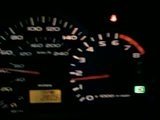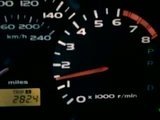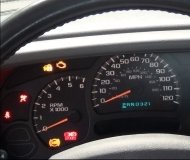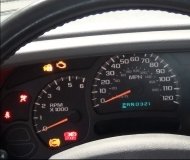Perform the following test and see if you come u with anything.
Idle Air Control Motor
1. Disconnect IAC motor connector. Check resistance between IAC motor connector terminal No. 2 and either terminal No. 1 or 3. Also check resistance between IAC motor connector terminal No. 5 and either terminals No. 4 or 6. Each resistance reading should be 28-33 ohms (Outlander: 26.5-32.5) at 68 °F (20 °C). If resistance readings are not as specified, replace IAC body assembly.
If resistance readings are as specified, go to next step.
2. If using lab scope, go to step 4. Engine coolant temperature must be 68 °F (20 °C) or less. If not, an Engine Coolant Temperature (ECT) sensor that is appropriate temperature can plugged into ECT sensor connector. Turn ignition on (engine off) and listen for IAC motor operation sound. Operational sound should be heard when ignition is turned on and off.
3. For testing IAC control circuit, perform diagnostic procedure for DTC P0506.
4. Using test harness, or backprobing, connect lab scope pick-up, in turn, to IAC motor connector terminals No. 1, 3, 4, and 6. With engine running, compare IAC motor waveform to normal waveform.
DTC P0506: IDLE CONTROL SYSTEM RPM LOWER THAN EXPECTED
Circuit Operation
"� The idle air control motor power is supplied from the MFI relay (terminal No. 4).
"� The ECM (terminals 4, 5, 17 and 18 - M/T) or PCM (terminals 14, 15, 28 and 29 - A/T) drives the stepper motor by sequentially turning "ON" the power transistors in the ECM (M/T) or PCM (A/T) and providing ground to the idle air control motor (terminals 1, 3, 4 and 6).
Technical Description
"� The amount of air taken in during idling is regulated by the opening and closing of the servo valve located in the air passage that bypasses the throttle body.
"� If there is a malfunction of the IAC system, the actual engine speed will not be identical to the target engine speed.
"� The ECM (M/T) or PCM (A/T) checks the difference between the actual engine speed and the target engine speed.
DTC Set Conditions
"� Check Conditions - Under the closed loop idle speed control. Engine coolant temperature is more than 171 °F (77 °C). Battery positive voltage is higher than 10 volts. Power steering pressure switch: "OFF". Volumetric efficiency is lower than 40%. Barometric pressure is higher than 11 psi (76 kPa). Intake air temperature is higher than 14 °F (-10 °C). 25 seconds have elapsed from the start of the previous monitoring. Target idle air control motor position is more than 100 steps.
"� Judgement Criteria - The actual idle speed is more than 100 RPM lower than the target idle speed for 12 seconds.
Probable Causes
"� Idle air control motor failed.
"� Open or shorted idle air control motor circuit, or loose connector.
"� ECM failed (M/T).
"� PCM failed (A/T).
Diagnostic Procedure
CAUTION:To prevent damage to scan tool (MB991502), always turn the ignition off before connecting or disconnecting it.
1. Connect scan tool (MB991502) to the data link connector. Turn the ignition on. Set the scan tool to read DTCs. Turn the ignition off. If a diagnostic trouble code other than P0506 is output, refer to the appropriate diagnostic procedure. Go to the next step.
2. Check the throttle body (throttle valve area). If the throttle valve area is dirty, clean it and proceed to step
14. If the throttle valve area is clean, go to the next step.
3. Check connector B-34 at idle air control motor for damage. If the connector is in good condition, go to the next step. If the connector is damaged, repair or replace it and proceed to step 14.
4. Check the idle air control motor coil resistance. Disconnect the idle air control motor connector B-34. Measure the resistance between idle air control motor connector terminal No. 2 and either terminals No. 1 or 3. Standard value: 28-33 ohm at 68 °F (20 °C). Measure the resistance between idle air control motor connector terminal No. 5 and either terminal No. 4 or terminal No. 6. Standard value: 28-33 ohm at 68 °F (20 °C). If the resistance is normal, go to the next step. If the resistance is abnormal, replace the idle air control motor
and proceed to step 14.
5. Check the power supply voltage at idle air control motor harness side connector B-34. Disconnect the connector B-34 and measure at the harness side. Turn the ignition on. Measure the voltage between terminals No 2, 5 and ground. Voltage should be battery positive voltage. Turn the ignition off. If the voltage is normal, proceed to step 7, otherwise, go to the next step.
6. Check connector A-18X at MFI relay for damage. If the connector is in good condition, repair harness wire between MFI relay connector A-18X terminal No. 4 and idle air control motor connector B-34 terminals No. 2, 5 (because of open circuit or short circuit to ground). If the connector is damaged, repair or replace it. Proceed to step 14.
7. Check the power supply voltage at ECM connector C-49 (M/T) or PCM connector C-50 (A/T) by backprobing. Do not disconnect the connector C-49 (M/T) or C-50 (A/T). Measure the voltage between terminals No. (4, 5, 17 and 18 - M/T) or (14, 15, 28 and 29 - A/T) and ground by backprobing. The voltage is 1 volts or lower for approximately 3 seconds, then changes to the battery positive voltage when the ignition switch is turned on. Turn the ignition off. If the voltage is normal, proceed to step 10, otherwise, go to the next step.
8. Check connector C-49 at ECM (M/T) or connector C-50 at PCM (A/T) for damage. If the connector is in good condition, go to the next step. If the connector is damaged, repair or replace it and proceed to step 14.
9. Check for open circuit and short circuit to ground between idle air control motor connector B-34 and ECM connector C-49 (M/T) or PCM connector C-50 (A/T).
A. Idle air control motor connector B-34 terminal No. 1 and ECM connector C-49 terminal No. 4 (M/T) or PCM connector C-50 terminal No. 14 (A/T).
B. Idle air control motor connector B-34 terminal No. 3 and ECM connector C-49 terminal No. 17 (M/T) or PCM connector C-50 terminal No. 28 (A/T).
C. Idle air control motor connector B-34 terminal No. 4 and ECM connector C-49 terminal No. 5 (M/T) or PCM connector C-50 terminal No. 15 (A/T).
D. Idle air control motor connector B-34 terminal No. 6 and ECM connector C-49 terminal No. 18 (M/T) or PCM connector C-50 terminal No. 29 (A/T).
If the harness wire is in good condition, replace the ECM or PCM, otherwise, repair it. Proceed to step 14.
10. Check connector C-49 at ECM (M/T) or connector C-50 at PCM (A/T) for damage. If the connector is in good condition, go to the next step. If the connector is damaged, repair or replace it and proceed to step 14.
11. Check the idle air control motor operation using special tool (MB991709). Remove the idle air control motor. Connect special tool (MB991709) to the idle air control motor. (All terminals should be connected.) Use the jumper wires to connect terminal No. 2 of the idle air control motor connector to the positive battery terminal. Check to ensure that the motor operates when the terminals 1 and 3 of the idle air control motor connector are respectively connected to the negative battery terminal using a jumper wire. Vibration should be present at each application of voltage to test clip combination. Use jumper wires to connect terminal No. 5 of the idle air control motor connector to the positive battery terminal. Check to ensure that the motor operates when terminals No. 4 and 6 of the idle air control motor connector are respectively connected to the negative battery terminal using a jumper wire. Vibration should be present at each application of voltage to test clip combination. Install the idle air control motor. If the idle air control motor is operating properly, go to the next step. If the idle air control motor is malfunctioning, replace the idle air control motor and proceed to step 14.
12. Check for harness damage between MFI relay connector A-18X (terminal No. 4) and idle air control motor connector B-34 (terminals No. 2 and 5). If the harness wire is in good condition, go to the next step. If the harness wire is damaged, repair it and proceed to step 14.
13. Check for harness damage between idle air control motor connector B-34 and ECM connector C-49 (M/T) or PCM connector C-50 (A/T).
A. Idle air control motor connector B-34 terminal No. 1 and ECM connector C-49 terminal No. 4 (M/T) or PCM connector C-50 terminal No. 14 (A/T).
B. Idle air control motor connector B-34 terminal No. 3 and ECM connector C-49 terminal No. 17 (M/T) or PCM connector C-50 terminal No. 28 (A/T).
C. Idle air control motor connector B-34 terminal No. 4 and ECM connector C-49 terminal No. 5 (M/T) or PCM connector C-50 terminal No. 15 (A/T).
D. Idle air control motor connector B-34 terminal No. 6 and ECM connector C-49 terminal No. 18 (M/T) or PCM connector C-50 terminal No. 29 (A/T).
If the harness wire is in good condition, replace the ECM or PCM, otherwise, repair it. Go to the next step.
14. Carry out a test drive with the drive cycle pattern. Check the diagnostic trouble codes. If DTC P0506 is output, retry the troubleshooting. If the DTC is
absent, the inspection is complete.
Saturday, October 9th, 2010 AT 4:06 PM





